Analysis
1/7/21
8 min min read
NFC Playoff Profiles
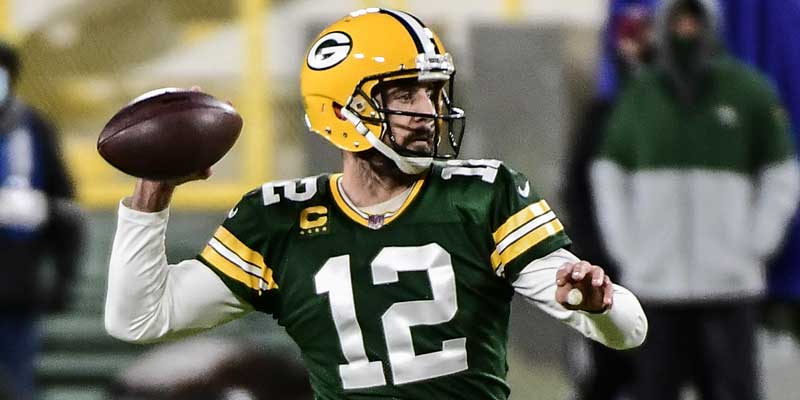

The 2021 NFL playoff brackets are set. Here’s a profile of the seven NFC playoff teams, complete with strengths, weaknesses and the opponent that each team most needs to avoid.
Before getting into the profiles below, a quick glossary of the statistics used:
- Expected Points Added (EPA): Is a statistic that measures the value of individual plays in terms of points. Every play has an Expected Points (EP) Value based on the context of down, distance, and field position. EPA measures the change in EP from the start of the play to the end of the play. By providing context of the play, a 3-yard gain on third-and-two has more EPA than one on first-and-10.
- Success Rate: A measure of efficiency that considers the context of play to deem whether a play is successful or not. A play is successful when it gains at least 40% of yards-to-go on first down, 60% of yards-to-go on second down and 100% of yards-to-go on third or fourth down.
- DVOA: Football Outsiders’ main statistic, it “breaks down the entire season play-by-play, comparing success on each play to the league average” based on the context of the game from down and distance to opponent quality.
- Adjusted Line Yards: A Football Outsiders’ statistic that separates the ability of a running back from the ability of the offensive line. Each play is adjusted based on situation and opponent quality.
- Adjusted Sack Rate: A Football Outsiders’ statistic that adjusts for pass rates, opponent quality, and down and distance. Since sacks are more common in certain situations, like on third down or third-and-long, it is a better measure of pass blocking than total sacks.
SEE ALSO: AFC Playoff Profiles
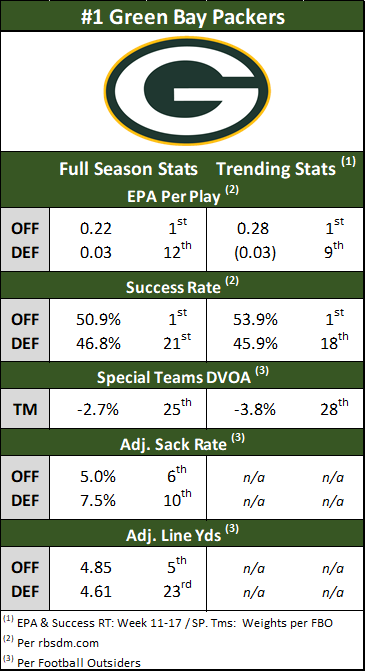

Playoff Outlook
Green Bay earned the NFC’s top seed on the back of a resurgent Aaron Rodgers, who leads the league in EPA/Play and is on his way to another MVP. While the Packers also won 13 games last season, this year’s outfit has significantly improved, raising its Net EPA/Play from 0.09 to 0.20 (first in the NFL). Moreover, the team is currently playing its best football, as it is tied with Buffalo for the league lead in Net EPA/Play since Week 11. Green Bay plays poor special teams and its defense is more susceptible on the ground at a middling 17th in DEF EPA/Rush. In the Packers three losses (TB, MIN, IND), the team allowed on average over 150 yards rushing, including a massive 163-yard, 3 touchdown game from Dalvin Cook.
Worst Matchup – New Orleans Saints
New Orleans, built on a strong running game, stout defense and good special teams, in theory is the worst matchup for Green Bay’s statistical profile. However, in Week 3, the Packers defeated the Saints 37-30 in New Orleans. The Saints defense was unable to stop Rodgers that day and a currently hobbled Drew Brees makes it less likely New Orleans can score with Rodgers. Green Bay’s potential second-round matchup, Tampa Bay, did defeat GB in Week 5 by the score of 31-10. But T.B.’s pass defense has regressed from a top 5 unit at that time and to a poor 20th since Week 11. Green Bay looks set up to make a deep playoff run.
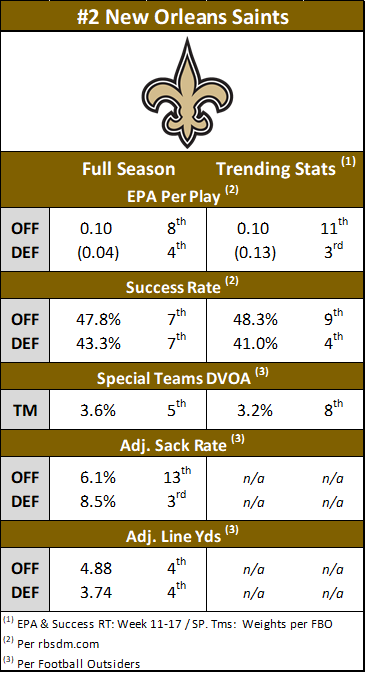

Playoff Outlook
New Orleans earned the No. 2 seed in the NFC despite losing Drew Brees for a month. The Saints are built around strong offensive and defensive lines, and are a complete team when fully healthy. The offense took a step back from its usual proficiency due to Brees and Michael Thomas injuries, but it remains an above-average unit. The formula for Saints victories relies on a strong rushing attack and efficient passing game, paired with strong defense and special teams. Brees has been solid in his three-game return, but the Saints Super Bowl chances depend on the upside created if Brees and Thomas are healthy.
Worst Matchup – Seattle Seahawks
Seattle offers interesting answers to the Saints' strengths and weaknesses that could cause problems if these teams meet in the second round. Seattle’s run defense is peaking, ranking fourth in EPA/Rush since Week 11 and its pass defense is just behind at 7th in EPA/Pass. While Russell Wilson has tailed off since his torrid start, the Seahawks offensive upside could cause issues for the Saints. New Orleans’s strong pass defense is built off its d-line pressuring the QB. While Seattle ranks 30th in Adj. Sack Rate, Wilson’s elusiveness has nullified this weakness in every year of his career, as Seattle has not ranked higher than 24th in Adj. Sack Rate since his rookie season.
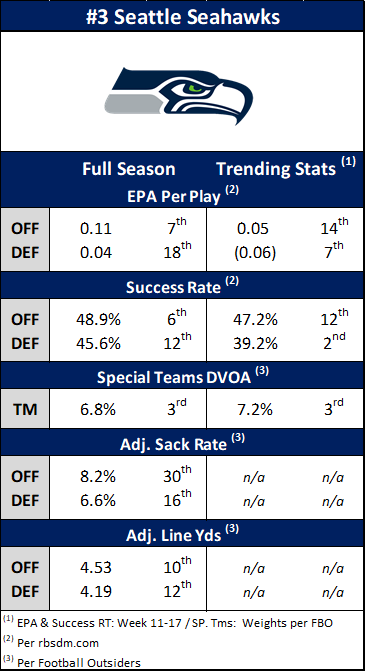

Playoff Outlook
Seattle’s statistical profile is a tale of two halves of the season. From Weeks 1-10, the Seahawks were fourth on offense in EPA/Play and 26th on defense. From Weeks 11-17, the Seahawks were on 14th on offense in EPA/play and seventh on defense. If Seattle can regain its early offensive form that relied on explosive plays primarily through DK Metcalf, this team will be dangerous. While the defense has seen a huge improvement, its resurgence coincided with playing offenses that ranked on average 26th in EPA/Play.
Worst Matchup – Tampa Bay Buccaneers
Despite Seattle’s defensive improvement, the team still struggles to generate pressure on the QB. Outside of Jamal Adams blitzes, the Seahawks do not have a dominant pass rusher to continually impact a game. This would be a serious issue when facing Tampa Bay, as the formula to defeat Tom Brady for his career and this season is pressure. Additionally, Tampa’s blitz-heavy defense would force Wilson to release the ball quickly. This would be detrimental to a passing offense that prefers longer-developing deep routes or Wilson buying time in the pocket to create explosive plays.
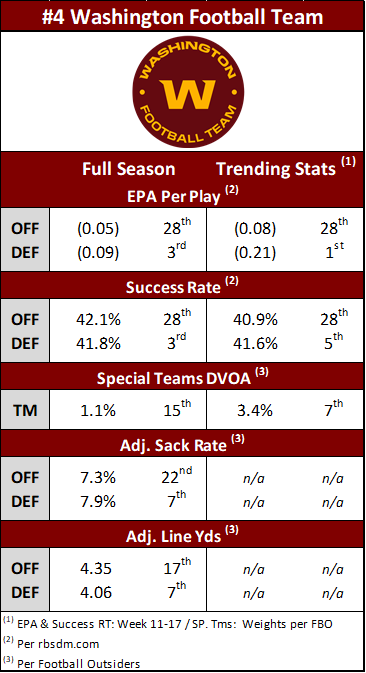

Playoff Outlook
One team had to win the NFC East, and while Washington was not exceptional, it was by far the best NFCE team in Net EPA/Play. Washington’s defense is tremendous, led by a strong defensive line. The Football Team’s pressure has driven its pass defense to first in the NFL in EPA/Pass since Week 11. Washington’s offense improved in the middle of the season, but a season-ending injury to Kyle Allen and now a nagging injury to Alex Smith has them sputtering. Without turnovers to feed the offense, the team struggles to score. Washington hopes to grind out victories with a competent running game that ranks ninth in EPA/Rush.
Worst Matchup – New Orleans Saints
Both NFC South teams present matchup issues for Washington due to strong run defense, but because of Brady’s propensity to struggle with pressure, New Orleans presents the worst possible matchup for the Football Team. The Saints defense at third in EPA/Rush would shut down Washington’s run game and the Saints high pressure scheme would be troublesome for an immobile Alex Smith.
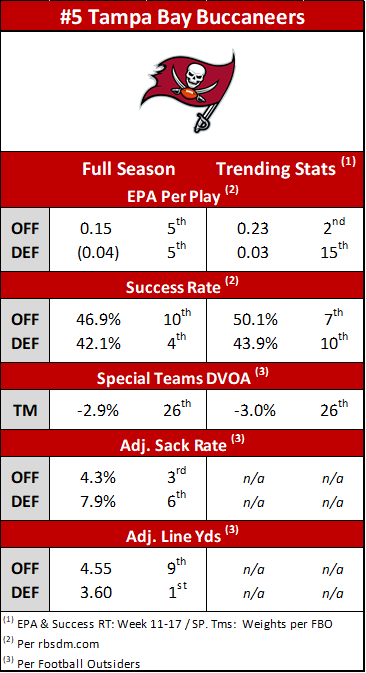

Playoff Outlook
Tom Brady’s first season in Tampa was uneven, but Tampa Bay is a strong contender that finished the season second in Net EPA/Play. The offense has been good throughout the season and it seems Brady is finally comfortable in Bruce Arians’ downfield scheme. The question becomes whether the Bucs late defensive slide will continue in the playoffs. After being one of the best Defenses in the NFL to begin the season, Tampa has fallen to 15th in Defensive EPA/Play since Week 11. While the run defense remains elite, the pass defense has been a mediocre 19th in EPA/Pass. The formula to defeat the Bucs is the same as it has been for Brady’s career: pressure him. Tampa has lost five games this season (NO twice, LAR, CHI, KC) and those opponents ranked on average eighth in Adjusted Sack Rate. Even though Tampa grades out well on offense in Sack Rate, this remains the main way to stifle the Buccaneers offense.
Worst Matchup – New Orleans Saints
Given the way the Saints matchup with Tampa, it is not surprising the Saints beat Tampa by 11 and 35 this season. In both games, the Saints defense pressured Brady a combined 23 times and forced 6 turnovers. While the Saints prefer to rely on their rush offense, they have shown a willingness to instead pass on Tampa and avoid its stout front seven. In both games, New Orleans did not have a rusher go over 54 yards, while Drew Brees racked up 6 touchdowns to 0 interceptions and only two sacks.
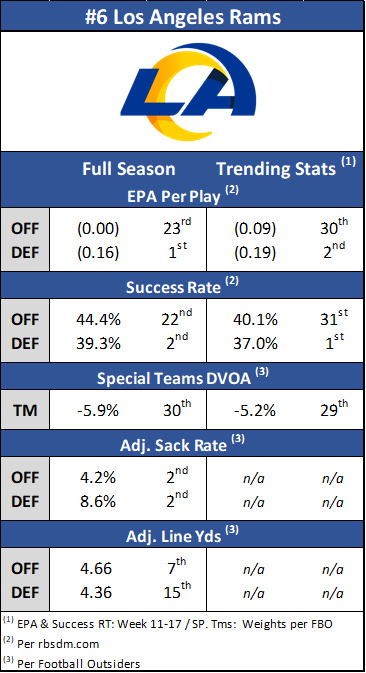

Playoff Outlook
In a departure from Los Angeles’ last playoff team, which lost in the Super Bowl, this edition of the Rams features a strong defense and a weak offense. The Rams defense finished first in the NFL in EPA/Play including first in EPA/Pass. This defense combines a ferocious pass rush led by Aaron Donald (second in Adj. Sack Rate) and a strong secondary led by Jalen Ramsey’s lockdown ability. Unfortunately for the Rams, Jared Goff has significantly declined and is now dealing with a fractured thumb. Backup QB John Wolford performed admirably in Week 17 to clinch a playoff spot, but ultimately the Rams do not win with their offense.
Worst Matchup – Green Bay Packers
Green Bay leads the NFL in points scored and would present major issues for Los Angeles. The Green Bay offensive line is one of the best in the NFL at sixth in Adjusted Sack Rate and first in ESPN’s Pass Block Win Rate. More troubling for the Rams is that Green Bay’s interior o-line can slow down Donald as GB’s center and both guards rank within the top 10 at their position in Pass Block Win Rate. Additionally, the Rams rely on Ramsey to shut down the other team’s number one option, but the Packers' Davante Adams is likely the best WR in the NFL right now. If Donald and Ramsey are nullified, the Rams would face the impossible task of keeping up with the best offense in the NFL.
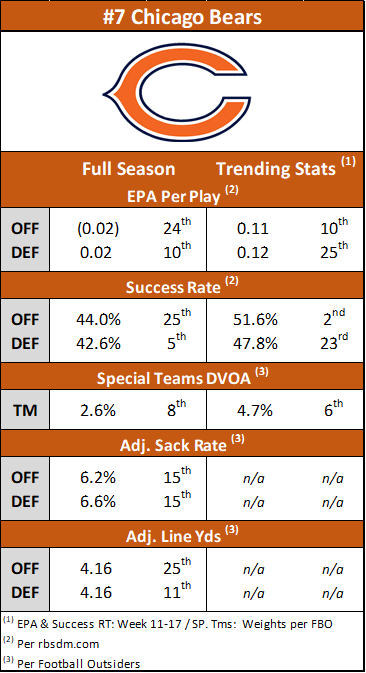

Playoff Outlook
Despite multiple QB changes, Chicago backed into the playoffs on the final day thanks to an Arizona loss. While Chicago is known for its defense, the unit has been weaker than expected. Despite ranking 10th in EPA/Play for the season, the defense has been regularly torched of late, ranking 25th in EPA/Play since Week 11. While the run defense remains good, the pass defense has struggled at 28th in EPA/Pass since Week 11. Chicago found new life on offense when it switched back to Mitch Trubisky, averaging 35 PPG from week 13-16. However, Chicago majorly benefited from poor opponents, as it played the three worst defenses in EPA/Play (Houston, Jacksonville, Detroit) and the 26th (Minnesota). The offensive resurgence immediately stalled when facing a quality defense, as Chicago only scored 16 points and averaged 4.8 yards per play against Green Bay in Week 17.
Worst Matchup – Green Bay Packers
The Packers have already demonstrated they are a matchup nightmare for Chicago, defeating the Bears by an average of 17.5 points. In both games, the Packers torched the Chicago passing defense as Rodgers threw for a combined 8 touchdowns and 0 interceptions. While David Montgomery and Chicago’s rush offense has improved of late, it still ranks 17th in EPA/Rush since Week 11 and would be unable to attack Green Bay’s main weakness. Meaning Chicago would need to rely on Trubisky to go toe-to-toe with the NFL’s potential MVP.
------------
NFC Playoff Prediction
The NFC playoffs are wide open, and I can see an argument for either Green Bay, New Orleans, Seattle or Tampa Bay. Ultimately, I believe Green Bay is too strong for any opponent to defeat them. If Tampa survives Washington in round 1, it will provide a tough test for the Packers as they have already defeated them. However, I believe that early-season loss will help the Packers and they would be able to fix the mistakes that plagued them in that game. From a purely statistical profile I believe New Orleans matches up best with Green Bay, but I would still expect the Packers to win a potential rematch in the NFC Championship Game. Green Bay reminds me of last year’s Chiefs as they pair a dominant passing offense with a defense peaking at the right time.








